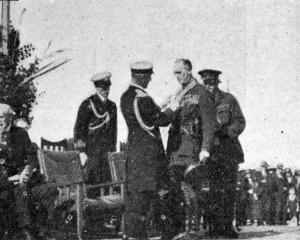It is a brownish bird, with a bright yellow bill and an extraordinarily voracious appetite.
On islands frequented by seals Nellies are often seen hovering over the sealers when they are engaged cutting up a seal, and as soon as the men leave the carcase these birds swoop down and gorge themselves on it.
The Nelly belongs to the same order as the albatross - the Tubinares - but has a much more laboured flight than that famous flier.
It is stated that when a person approaches the nest of a Nelly the old bird keeps short way off, and the young ones squirt a horribly-smelling oil out of their mouths for a distance of 6ft or 8ft.
The specimen caught at New Brighton, which eats ravenously, will be kept alive at the Museum.
Ashburton, June 17. Yesterday, on account of having strong suspicions that sly grog-selling was going on at a certain house in Peter Street, the police raided the premises, and discovered the largest amount of liquor which has yet been found in any house since no-license was carried in Ashburton.
A small quantity was discovered in the house, but the police were not satisfied, and they conducted a systematic search of the garden.
An empty sack excited suspicion, and the police stuck a spade into the ground near it.
A shovelful of earth was thrown out, and a neat little cache, made out of a kerosene tin, was disclosed, containing a large number of bottles of whisky.
Further down another ''strike'' was made, and a second hiding place was discovered.
This was made of bricks and a still larger quantity of bottles was found.
A reptile was last week presented to the Invercargill Museum by Mr A Biggar, of Waikaka Valley (says the Southland Times).
This was a fine example of the spotted lizard (naultinus elegans). It is olive-brown in colour, with a double row of irregular, leaflike paler spots on the back and a single series along the tail.
Though very seldom met with, it may be much more common than is generally supposed, and its colouration is evidently protective, and among the mosses and lichens of the bush where it lives it may often be passed over unnoticed.
The Hawera Star states the Mr H D MacDonald has patented an apparatus for the weighing and sampling of milk from machine-milked cows.
Mr MacDonald claims that his machine will weigh automatically and correctly each cow's milk, and simultaneously extract a true sample for testing purposes.
At present the greatest drawback to machine milking is that most farmers in a great measure are working in the dark as regards their best cows; but, if by a single attachment to the present milking machines the apparatus can automatically do what is claimed for it by Mr MacDonald, it will be of inestimable value to the dairy industry of the whole of Taranaki.
Football is dead for the present in the Wanaka district (says a correspondent of the Cromwell Argus); a great number of the players from both Hawea and Wanaka Clubs having decided that the claim on their services by their King and country was a great deal more urgent than the call ''on the ball''. - ODT, 18.6.1915.












